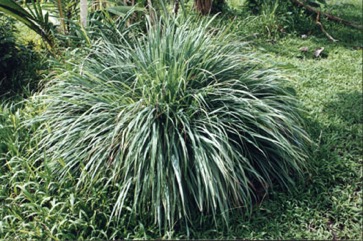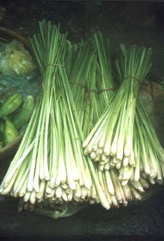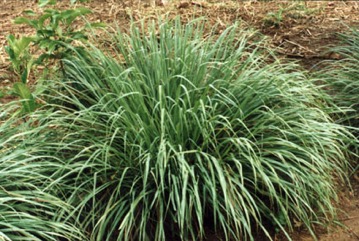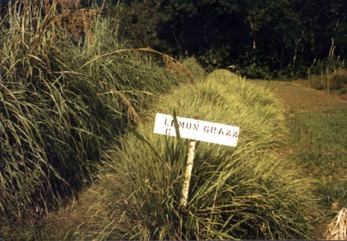Lemon grass

It is a tropical and subtropical plant. It occurs in coastal areas and up to at least 1400 m altitude. It is a good plant for borders and erosion control. They are frost tender. It needs a temperature above 10°C to grow. It needs good drainage. In Argentina it grows from sea level to 2,700 m above sea level. It suits hardiness zones 9-11. In Yunnan.
Also known as:
Agin ghas, Belgata, Bhustrina, Caboi, limon, Cana santa, Canita de Cedron, Du'ut-morin, Enyait, Erva-cidreira, Fiji char, Gandhabena, Gandhatrina, Ge lao dang, Ghanda, Herva chaha, Herva chela, Heung masu tso, Hierba luisa, Hirua cha, Kaasinjee, Kagatighaans, Khawi, Lili cha, Limonska trava, Mah keng, Majjigehullu, Mao xiang cao, Moegalo, Moejara, Nimmagaddi, Olecha, Pirheghaans, Po pi, Reh pwo mwahu, Remon gurasu, Remon-sou, Sabalin, Sa chanh, Saineroil, Sa kai, Sera, Serai, Sere, Sereh betul, Sereh makan, Sereh sayur, Sereh, Shahai, Shakai, Sinda, Sinda dimputu, Sinde, Slek krei sabu, Sok aphi, Sontol, Ta krai, Takrai, Tanglad, Tanlag, Thej sar, Vasanappillu, Vasanappulla, Veromanitra, West Indian lemongrass, Xa, Xiang mao coa, Yerba de limon, Zabalin, Zacate limon
Synonyms
- Andropogon ceriferus Hackel
- Andropogon citratus DC.
- Andropogon nardus (L.) Rendle var. ceriferus Hackel
- Andropogon esculentum Kurz.
Edible Portion
- Leaves, Herb, Spice, Lower stem, Leaves - tea
Where does Lemon grass grow?
Found in: Africa, Angola, Argentina, Asia, Australia, Bangladesh, Benin, Bolivia, Botswana, Brazil, Cambodia, Central Africa, Central America, Chile, China, Congo DR, Cook Islands, Costa Rica, Cuba, East Africa, East Timor, Ecuador, Ethiopia, Fiji, FSM, Gabon, Grenada, Guatemala, Guiana, Guianas, Guinea, Guinée, Guinea-Bissau, Guyana, Haiti, Hawaii, Honduras, India, Indochina, Indonesia, Japan, Kenya, Kiribati, Kosrae, Laos, Madagascar, Malaysia, Maldives, Mali, Marquesas, Mauritius, Mexico, Micronesia, Mozambique, Myanmar, Nepal, New Caledonia, Nicaragua, Niger, North America, Northeastern India, Pacific, Palau, Papua New Guinea, PNG, Peru, Philippines, Pohnpei, Rotuma, Samoa, Sao Tome and Principe, SE Asia, Sierra Leone, Singapore, Slovenia, Solomon Islands, South Africa, Southern Africa, South America, Sri Lanka, St. Kitts and Nevis, St Lucia, Suriname, Taiwan, Tanzania, Tasmania, Thailand, Timor-Leste, Tonga, Tuvalu, Uganda, United States, Vanuatu, Vietnam, West Africa, West Indies, Zambia, Zimbabwe
Notes: Lemon grass oil is used in perfumes and medicines. There are 56 Cymbopogon species. It has 2.3 mg per 100 g dry weight and 1.12 mg fresh weight of alpha-tocopherol (Vitamin E).
Status: It is sold in local markets.
Growing Lemon grass
Cultivation: It is grown from portions of the clump. A spacing of about 1 m between clumps is needed. Plants can be easily grown by putting the stem end of a shoot in water until roots form then planting out. It can also be grown by seeds. Being very small they are mixed with ash or sand. They can be sown directly. They can also be put in a nursery and transplanted.
Edible Uses: It is mostly used as a flavouring in lemon grass tea and stews. The leaves can be dried and stored for use in tea. The very young fleshy white bases of the shoots are used in Asian cooking. The outer layers are peeled off.
Production: It can be cut 4-8 months after planting and then every 3-4 months. Harvesting can continue to 3-4 years.
Nutrition Info
per 100g edible portion| Edible Part | Energy (kcal) | Protein (g) | Iron (mg) | Vitamin A (ug) | Vitamin c (mg) | Zinc (mg) | % Water |
|---|---|---|---|---|---|---|---|
| Leaves | 116 | 1.4 | 2.8 | 3 | 1.8 | 0.6 | 70.3 |
Lemon grass Photos




References
Agea, J. G., et al 2011, Wild and Semi-wild Food Plants of Bunyoro-Kitara Kingdom of Uganda: etc. Environmental Research Journal 5(2) 74-86
Alegado, A. M. & De Guzman, R. B., 2014, Indigenous food crops of the Aetas tribe in the Philippines and their traditional methods of food preparation. in Promotion of Underutilized Indigenous Food Resources for Food Security and Nutrition in Asia and Pacific. FAO. Bangkok p 160
Ambasta, S.P. (Ed.), 2000, The Useful Plants of India. CSIR India. p 155
Anderson, E. F., 1993, Plants and people of the Golden Triangle. Dioscorides Press. p 208
Bernholt, H. et al, 2009, Plant species richness and diversity in urban and peri-urban gardens of Niamey, Niger. Agroforestry Systems 77:159-179
Batet, K., Koil, U., and Hertel, H., 1998, Traditional Plant Use by the Didipa Clan, Baitabag, Papua New Guinea. GDS. p 27
Bennett, B. C., 1990, Useful Plants of Amazonian Ecuador. US Agency for International Development. Fifth Progress Report. New York Botanical Gardens. p 39
Borrell, O.W., 1989, An Annotated Checklist of the Flora of Kairiru Island, New Guinea. Marcellin College, Victoria Australia. p 22
Bremness, L., 1994, Herbs. Collins Eyewitness Handbooks. Harper Collins. p 164
Brickell, C. (Ed.), 1999, The Royal Horticultural Society A-Z Encyclopedia of Garden Plants. Convent Garden Books. p 331
Brown, D., 2002, The Royal Horticultural Society encyclopedia of Herbs and their uses. DK Books. p 187
Bull. Misc. Inform. Kew 1906:322, 357. 1906
Burkill, H. M., 1985, The useful plants of west tropical Africa, Vol. 2. Kew.
Burkill, I.H., 1966, A Dictionary of the Economic Products of the Malay Peninsula. Ministry of Agriculture and Cooperatives, Kuala Lumpur, Malaysia. Vol 1 (A-H) p 735
Burnie, G & Fenton-Smith, J., 1999, A Grower's Guide to Herbs. Murdoch Books. p 45
Cao, Y., et al, 2020, Ethnobotanical study on wild edible plants used by three trans-boundary ethnic groups in Jiangcheng County, Pu’er, Southwest China. Journal of Ethnobiology and Ethnomedicine (2020) 16:66
Cheifetz, A., (ed), 1999, 500 popular vegetables, herbs, fruits and nuts for Australian Gardeners. Random House p 124
Chin, H. F., 1999, Malaysian Vegetables in Colour. Tropical Press. p 85
Ching, L. S. & Mohamed, S., 2001, Alpha-Tocopherol Content in 62 Edible Tropical Plants. J. Agric. Food Chem. 2001, 49, 3101−3105
Cobley, L.S. (rev. Steele, W.M.) 2nd Ed., 1976, An Introduction to the Botany of Tropical Crops. Longmans. p 331
Coe, F. G., and Anderson, G. J., 1996, Ethnobotany of the Garifuna of Eastern Nicaragua. Economic Botany 50(1) pp 71-107
Coe, F. G. and Anderson, G. J., 1999, Ethnobotany of the Sumu (Ulwa) of Southeastern Nicaragua and Comparisons with Miskitu Plant Lore. Economic Botany Vol. 53. No. 4. pp. 363-386
Creasy, R., 2000, The Edible Asian Garden. Periplus p 45
Cundall, P., (ed.), 2004, Gardening Australia: flora: the gardener's bible. ABC Books. p 457
Ekman Herbarium records Haiti
Facciola, S., 1998, Cornucopia 2: a Source Book of Edible Plants. Kampong Publications, p 174
Foo, J.T.S.(ed), 1996, A Guide to Common Vegetables. Singapore Science Foundation. p 73
Fowler, D. G., 2007, Zambian Plants: Their Vernacular Names and Uses. Kew. p 69
French, B.R., 1986, Food Plants of Papua New Guinea, A Compendium. Asia Pacific Science Foundation p 340
French, B.R., 2010, Food Plants of Solomon Islands. A Compendium. Food Plants International Inc. p 317
Godfrey, J. et al, 2013, Harvesting, preparationand preservation of commonly consumed wild and semi-wild food plants in Bunyoro-Kitara Kingdom, Uganda. Int. J. Med. Arom. Plants. Vol.3 No.2 pp 262-282
Grivetti, L. E., 1980, Agricultural development: present and potential role of edible wild plants. Part 2: Sub-Saharan Africa, Report to the Department of State Agency for International Development. p 30
Hani Medicine of Xishuangbanna, 1999, p 551
Hemphill, I, 2002, Spice Notes. Macmillan. p 221
Hibbert, M., 2002, The Aussie Plant Finder 2002, Florilegium. p 79
Hu, Shiu-ying, 2005, Food Plants of China. The Chinese University Press. p 287
Hutton, W., 1997, Tropical Herbs and Spices of Indonesia. Periplus. p 38
Kiple, K.F. & Ornelas, K.C., (eds), 2000, The Cambridge World History of Food. CUP p 433, 1800
Koni, J. & Bostoen, K., 2008, Noms et usages des plantes utiles chez les Nsong. (RD Congo, Bandundu, bantu B85F). University of Gothenburg.
Larkcom, J., 1991, Oriental Vegetables, John Murray, London, p 127
Latham, P., 2004, Useful Plants of Bas-Congo province. Salvation Army & DFID p 104
Lautenschläger, T., et al, 2018, First large-scale ethnobotanical survey in the province of Uíge, northern Angola. Journal of Ethnobiology and Ethnomedicine (2018) 14:51
Lentz, D. L., 1986, Ethnobotany of the Jicaque of Honduras. Economic Botany 40(2):210-219
Li, D. et al, 2017, Ethnobotanical survey of herbal tea plants from the traditional markets in Chaoshan, China. Journal of Ethnopharmacology. 205 (2017) 195-206
Marinelli, J. (Ed), 2004, Plant. DK. p 267
Martin, F.W. & Ruberte, R.M., 1979, Edible Leaves of the Tropics. Antillian College Press, Mayaguez, Puerto Rico. p 194
Maundu, P. et al, 1999, Traditional Food Plants of Kenya. National Museum of Kenya. 288p
Medhi, P. & Borthakur, S. K., 2012, Phytoresources from North Cachur Hills of Assam -3: Edible plants sold at Hflong market. Indian Journal of Natural Products and Resources. 3(1) pp 84-109
Miguel, E., et al, 1989, A checklist of the cultivated plants of Cuba. Kulturpflanze 37. 1989, 211-357
Molla, A., Ethiopian Plant Names. http://www.ethiopic.com/aplants.htm
Mulherin, J., 1994, Spices and natural flavourings. Tiger Books, London. p 56
Norrington, L., & Campbell, C., 2001, Tropical Food Gardens. Bloomings Books. p 67
Ochse, J.J. et al, 1931, Vegetables of the Dutch East Indies. Asher reprint. p 299 (As Andropogon citratus)
Ojelel, S. & Kakudidi, E. K., 2015, Wild edible plant species utilized by a subsistence farming community in the Obalanga sub-county, Amuria district, Uganda. Journal of Ethnobiology and Ethnomedicine. 11:7
Owen, S., 1993, Indonesian Food and Cookery, INDIRA reprints. p 83
Phon, P., 2000, Plants used in Cambodia. © Pauline Dy Phon, Phnom Penh, Cambodia. p 189
Plants of Haiti Smithsonian Institute http://botany.si.edu/antilles/West Indies
PROSEA handbook Volume 13 Spices. p 276
Purseglove, J.W., 1972, Tropical Crops. Monocotyledons. Longmans p 136
Rajendra, K.C., 2014. Prominent Non-Wood Forest Products of Te- rai and Siwalik Regions in Nepal. Food and Agriculture Organization, Kathmandu, Nepal. p 71
Recher, P, 2001, Fruit Spirit Botanical Gardens Plant Index. www.nrg.com.au/~recher/ seedlist.html p 2
Reis, S. V. and Lipp, F. L., 1982, New Plant Sources for Drugs and Foods from the New York Botanical Garden herbarium. Harvard. p 10
Ruiters-Welcome, A. K., 2019, Food plants of southern Africa. Ph.D. thesis. Univ. of Johannesburg p 87
Salako, V. K. et al, 2013, Home gardens: an assessment of their biodiversity and potential contribution to conservation of threatened species and crop wild relatives in Benin. Genet Resour Crop Evol
Sang, D. T., & Mizoue, K. O. N., 2012, Use of Edible Forest Plants among Indigenous Ethnic Minorities in Cat Tien Biosphere Reserve, Vietnam. Asian Journal of Biodiversity Vol. 3 (1), p 23-49
Seidemann J., 2005, World Spice Plants. Economic Usage, Botany, Taxonomy. Springer. p 129
Soenarko, S., 1977, The Genus Cymbopogon Sprengel (Gramineae) Reinwardtia 9:225-375.
Solomon, C., 2001, Encyclopedia of Asian Food. New Holland. p 218
Staples, G.W. and Herbst, D.R., 2005, A tropical Garden Flora. Bishop Museum Press, Honolulu, Hawaii. p 745
Sujanapal, P., & Sankaran, K. V., 2016, Common Plants of Maldives. FAO & Kerala FRI, p 100
Sukenti, K., et al, 2016, Ethnobotanical study on local cuisine of the Sasak tribe in Lombok Island, Indonesia. Journal of Ethnic Foods. 3 (2016) 189-200 p 198
Teron, R. & Borthakur, S. K., 2016, Edible Medicines: An Exploration of Medicinal Plants in Dietary Practices of Karbi Tribal Population of Assam, Northeast India. In Mondal, N. & Sen, J.(Ed.) Nutrition and Health among tribal populations of India. p 154
Terra, G.J.A., 1973, Tropical Vegetables. Communication 54e Royal Tropical Institute, Amsterdam, p 43
Thaman, R.R., 1976, The Tongan Agricultural System, University of the South Pacific, Suva, Fiji. p 394
Thaman, R. R, 2016, The flora of Tuvalu. Atoll Research Bulletin No. 611. Smithsonian Institute p 52
van Wyk, B., 2005, Food Plants of the World. An illustrated guide. Timber press. p 169
Vickery, M.L. and Vickery, B., 1979, Plant Products of Tropical Africa, Macmillan. p 81
Williams, C.N., Chew, W.Y., and Rajaratnam, J.A., 1989, Tree and Field Crops of the Wetter Regions of the Tropics. Longman, p 228
Woodward, P., 2000, Asian Herbs and Vegetables. Hyland House. p 64
World Checklist of Useful Plant Species 2020. Royal Botanic Gardens, Kew
Xu, You-Kai, et al, 2004, Wild Vegetable Resources and Market Survey in Xishuangbanna, Southwest China. Economic Botany. 58(4): 647-667.